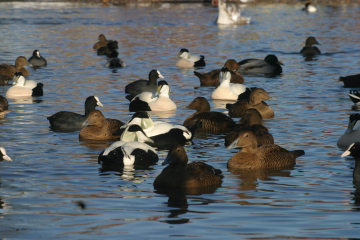Top 5 things to watch for on eider ducks

Eider ducks are a firm favourite with visitors here at Washington Wetland Centre. But from their unique call to growing beak, here's a list of quirky features to keep an eye out for when visiting our eider ducks
1. Their call. We mentioned it earlier but they really do have the funniest and certainly most distinct call of our collection birds. The famous 'ooOOoo' sound from male common eiders welcomes visits entering Close Encounters, especially during the breeding season from March onwards. Keep an ear out for it!
2. Downy feathers. If you're every lucky enough to see an eider nest, you'll see it is lined using downy feathers which a mother eider will pluck from her own chest. These feathers help keep the ducklings warm for the first few days until they leave the nest.

3. They have a beak that keeps growing. If you look closely at an eiders bill, you'll notice that the curved end on the top beak of some birds may be longer than on others. This is because, much like our fingernails, the bill continues to grow helping them feed on muscles and crustaceans out at sea. In the wild, this would naturally be kept under control while rubbing against rocks and stones, but here at Washington, our keepers keep a regular check on these bird's beaks and trim them down whenever needed (usually every 6-12 month) - pretty cool right!
4. Their size. Not only are they the largest duck in our Close Encounters exhibit, but they are the largest duck in Europe. Look closely at the size difference between them and the other ducks within the exhibit, particularly the smew which is one of our smallest ducks.

5. Multi-purpose wings. Due to the size of an eider's body they are incredibly boyuant, making diving a little more difficult. They use their wings to propell themselves underwater, much like a penguin would, helping them hunt under water.



